#so connect that to akira's personality in general and not just his rebellion. he's not very childish usually
Text
why do we always give akiren shitty parents in fics but never any siblings
#not gonna do it in adrwtt but. very much want to#what if he had older siblings who he feels are more successful and unique than him so he starts acting out bc of that.#no i am not projecting. why would you think that. shut up.#okay but really it makes sense for him to be a younger sibling trust me#you know how the velvet attendats' age is supposed to reflect the maturity of the protag? Yeah#idk if it's a confirmed thing but it does make a lot of sense imo. esp when ppl view rebellion as a childish thing#so connect that to akira's personality in general and not just his rebellion. he's not very childish usually#BUT what if it's only due to circumstances (his life in general but also being a silent protagonist lol) not allowing him to be immature#see it can work for a little sibling. right? right? am i projecting at this point? probably? oh well
8 notes
·
View notes
Text
loki appreciation agenda continues because i am speculating on the reasons why goro can change outfits. this is a super speculation-heavy post on goro’s outfit-changing abilities based on theories that loki was created through experimentation to force goro to awaken a second persona, and i don’t think i can necessarily “prove” anything in this post, but the lore on how personas work surprisingly checks out so it’s plausible if nothing else.
anyway, i think goro has two different outfits because he awakened to his “first” persona, twice.
explanation under cut:
(FIRST of all, i know there’s doylist explanations for why certain characters get new outfits and others don’t. this is a watsonian explanation because i have goro akechi brainworms and i cannot stop thinking about my boy.)
the basic premise is that your outfit is something you get when you have the will to rebel. outfits manifest when you’re in a palace that sees you as an enemy, thus activating your rebellious spirit to tell them to suck a dick.
that rebellious spirit comes from a moment of resolve: knowing that you don’t want to die, knowing what it is that you fight for, and knowing whose ass you want to beat. usually, then the character manifests a mask, hears the voice of their persona inside them, and they rip it off.
the will of rebellion also typically triggers a character awakening to their first persona. i’m going to call it the starter persona.
insofar as i can tell, a starter persona is a very specific type of persona that comes from a very specific type of phenomenon:
the manifestation of your resolve/will of rebellion
the persona you get when you awaken to your persona-using abilities for the first time
the first form of your persona
a persona that is unique to you and your soul
theoretically a persona that comes from within you, rather than an external source (e.g. shadow negotiations or the velvet room)
a persona gained under extreme duress marking a drastic resolve in oneself
a starter persona is not:
an evolved edition of your starter persona due to a moderate change in yourself (second-tier/third-tier awakening)
a new persona gained through capturing a shadow (akira’s new personas)
a new persona gained through fusing pre-existing personas (velvet room)
when a second-tier persona occurs, or a new persona is gained through shadow capture or fusing, a new outfit is not gained, because outfits come with the starter persona only.
so my theory is that robin hood and loki are both “starter” personas, even though loki was gained ostensibly way, way after goro had awakened to his general ability to summon personas. loki is not a persona that was gained through shadow negotiations or the velvet room, and loki is not an evolved form of robin hood, since robin hood and loki coexist and first-tier personas disappear when they turn into second-tier personas.
loki is basically as if goro underwent his first awakening, but a second time, and that’s why there’s a separate outfit for him, in the same way that all the phantom thieves get an outfit when they awaken for the first time.
and now i’m going to go into way too much detail about how starter personas are a very hyper-specific phenomenon that are different from the wild card ability to gain multiple personas and are also different from second-tier awakenings:
CASE ONE: wild cards
wild cards demonstrate very well that starter personas are unique in that they’re created from within a persona user, whereas other personas that wild cards can wield must come from outside sources. and even for wild cards who have six jillion personas, they really only have one starter persona (and in akira’s case, one accompanying outfit).
i think it’s alright to assume there’s something unique about arsene in relation to akira, in the same way that izanagi is unique to souji or orpheus is unique to minato. every other persona that these wild cards get have to be gotten from either capturing shadows in the wild, or from fusing captured shadows in the velvet room. they’re personas that are found from outside of the wild card, and then taken in to become one of the wild card’s masks.
by contrast, arsene, izanagi, and orpheus seem to come from “within” the wild cards, in the same way that any non-wildcard undergoes an awakening to pull a persona from inside themselves. arsene, izanagi, and orpheus aren’t gained through capturing a pre-existing shadow or fusing pre-existing shadows. so even though akira and other wild cards can wield multiple personas, all of them only have one starter persona.
i’d theorize that, although wild cards have the ability to wield many different masks, the other personas are more like impermanent additions to the general ability to wield multiple personas, which comes with the starter persona. (arsene and izanagi in particular seems really stick around even when you fuse him away, especially since arsene comes back in a second-tier awakening as satanael and izanagi as izanagi-no-okami.)
(NOW THAT I’VE SAID THAT, according to persona lore, all personas come from the sea of the soul! i did not forget. when i’m making the distinction between a persona that comes from “within” a persona user and a persona that has to be found externally, i mean that all shadows/personas ultimately come from the vast sea of the soul/collective unconscious that connects all human beings, but these personas get obtained through different ways: starter personas seem to be summoned from the sea of the soul entirely internally, whereas other shadows have to be summoned from the sea of the soul from either finding them in palaces, mementos, or the velvet room.)
akira, obviously, does not get a new outfit every time he gets a new persona, although that would have been cool as fuck. the outfit happens only when the starter persona is awakened--the persona from within akira, rather than a persona he acquired from the outside.
CASE TWO: general persona users and second tier awakenings
normal persona users don’t have the ability to find external shadows and make them into their own persona. normal persona users have only their starter persona which they got from within themselves, in the same way arsene is unique to akira, and are born from a moment of internal resolve. their personas are all “internal affairs,” so to speak.
normal persona users also have the option of a second-tier awakening, though. second-tier awakenings involve only the starter persona, a new resolve in the character, and again seem to be a persona that comes from “within.” so it seems a bit like the persona user has “awakened” a second time. it’s certainly an entirely internal event, requiring no additional personas obtained from palaces, mementos, or the velvet room.
but the second-tier persona is not an entirely new starter persona. second-tier personas are just their pre-existing already-awakened starter personas changing into a slightly different persona with the same abilities. second-tier personas inherit all the stats and abilities from the first as well, a bit as if it’s just the starter persona in a different form. so although the phantom thieves “awaken” a second time, it’s not so much an awakening so much as it is just an evolution of a pre-existing persona.
this makes sense in terms of the “personas manifest as a will/resolve to rebel” logic, too. it’s not necessarily that they manifested an entirely new resolve to rebel; their pre-existing resolve to rebel just evolved, changed, or was reaffirmed.
there’s also a visual cue for this: awakening a starter persona is a whole fucking deal involving a stressful situation, thinking you’re going to die, usually having to face some asshole in your life who abused you, hearing voices, screaming, manifesting your mask and ripping your face off. second-tier awakenings don’t involve this lmao. god could you imagine if it did. it’d actually be so funny tbh
second-tier awakenings, also, seem to be a phenomenon specific to “starter” personas, or personas obtained from within. you wouldn’t see a persona that akira got from a shadow negotiation evolve in the same way that arsene evolves into satanael, or carmen evolves into hecate, or izanagi evolves into izanagi-no-okami. you could argue that “high pixie” is a second-tier of “pixie,” but there’s no way to make pixie have new resolve and evolve into high pixie like a pokemon; pixie would have to be fused with some other persona to create high pixie. personas obtained through external means have to be fused with other personas, or absorb the life force of other personas through executions.
anyway, to get back to the point about goro’s two-outfit deal, second-tier awakenings also don’t get you new outfits. which makes sense if we assume that outfits come with obtaining a starter persona, since second-tier awakenings are just your starter persona evolving and is not actually an event in which you obtain an entirely new starter persona.
CASE THREE: haru and sumire
weird fact i forgot until i wrote this meta!! but both haru and sumire are cases of people who got their outfits and a “semi-awakening” to their personas, that then led to a period of not quite being able to actually summon their persona. so, from what we can understand, their will to rebel is there, just not solidified enough to manifest a persona.
morgana, our resident lore expert, tells us that when haru has her outfit but not her persona, milady is more or less there already, just confused due to conflicted feelings about haru’s father, and therefore can’t fully take shape. so she can sort of summon milady, but just not in an effective way that can deal battle damage.
personally i think this is just the atlus writers creating a reason to have haru in the palace in cute clothes without having her go through an awakening, so that she could awaken later for full dramatic effect. but since morgana went to such lengths to explain the mechanics of it and tell us that milady is technically already there, it’s a really interesting case study that demonstrates outfits are not something that are specific to having a starter persona, but doesn’t guarantee that that persona can be summoned.
the same thing happens to sumire: she gets her outfit sometime in october, and for some reason can use cendrillon up until she remembers that she’s sumire and not kasumi. then she winds up in a state like haru’s, where she has an outfit, has the will to rebel, and technically even has cendrillon, but she just can’t summon cendrillon. then she has to go through the whole song and dance of ripping her face off to awaken to cendrillon (which might be kasumi’s soul depending on the interpretation of the scene). and of course, from there her starter persona can have a second-tier and third-tier awakening to vanadis and ella.
but it looks like the same case as haru, ultimately: she technically had cendrillon, but wasn’t able to use it or manifest it because her resolve was jank as fuck with all her identity issues.
SO BASICALLY:
what i’m getting at is that the outfits come from awakening to a starter persona only.
a starter persona is, as shown above, a hyper-specific phenomenon in which you pull a persona out of your soul, as opposed to capturing an external shadow and adding it to your pre-existing persona abilities, or transforming your pre-existing persona into a new one. awakening your "first” persona is a thing that happens only when you dig up all the weird sediment from your soul when you think you’re going to die, generally. starter personas come from a moment of internal resolution, and the resulting persona seems to be unique to that person and the circumstances of the persona’s awakening.
really, it’s such a theatrical ordeal, too. like i mentioned before, starter personas get obtained through this WHOLE fucking ritual involving stress, hearing the voice of your persona inside you, manifesting your mask, ripping your face off, manifesting your outfit, etc, etc. (i think it’s fairly important to note that ripping the mask off is the first instance of the larger outfit showing up, too; the mask itself, the outfit, and the starter persona seem to come hand in hand.)
we already know that loki is not a second-tier awakening of robin hood, because robin hood co-exists with loki. we also know that loki is not a persona gained through shadow negotiation or fusion, because external personas that are gained through those methods don’t come with an outfit.
so it really looks like goro just manifested the internal will to rebel, and the accompanying new outfit and entirely new persona, twice.
this, actually, fits really well with the medical experimentation thing, since starter personas, the will to rebel, and the outfit seem to come from stressful situations, where the persona user, in an attempt to not die, pulls a new persona out of their soul from no external source. if the featherman game is implying what i think it is, shido’s scientists and maybe wakaba were trying to force a persona out of goro with stress and trauma, in the same way that you’d manifest a persona for the first time. these scientists were not handing him shadows to turn into personas, like how the wild card is intended to be used. these scientists were not trying to transform robin hood into a new form, like how a second-tier awakening is supposed to work. they were inducing the same conditions that you’d need to awaken a persona for the first time.
it also makes sense from an in-universe perspective, because i’m assuming that, since goro and these cognitive psientists didn’t know jack shit about the metaverse at the time, goro just told them what he knew about persona awakenings: he awoke to robin hood under duress, he reached into his soul, found robin hood there, did a bunch of yelling, pulled off his face, BAM. robin hood. so the scientists said, well, if you wanna see a phenomenon a second time, you might as well recreate the conditions from the first time, right? make him pull off his face again and see what happens.
that would explain how loki is unique to him, in the same way that arsene is unique to akira, or any of the other personas are unique to their phantom thieves. it would explain why there’s an accompanying outfit to go with loki as well--it’s literally an entirely different “first” awakening, as if he manifested the ability to summon a persona twice, rather than just adding on new personas to his pre-existing ability. and it also explains how he has two unique personas that are separate from each other.
it also explains why he never seems to, say, use robin hood while in the black mask outfit, and why he never uses loki while in the white crow outfit. it’s not a cosmetic choice; the outfit is tied to the persona he’s using at the time. the outfit is tied to the separate awakening, and the separate “first” persona that was generated from that awakening. (EDIT: goro does actually use loki very briefly while still in the white crow outfit during his boss battle, although presumably loki is not “fully” summoned because loki is blacked out/colored strangely/vaguely see-through.)
(meanwhile, hereward doesn’t get a new outfit to match him because he’s a tiered transformation awakening. a pre-existing power gets transformed. hereward even existing is also good evidence that robin hood and loki are “starter” personas rather than personas gained through external means, since shadows obtained through mementos/palaces/velvet room don’t get tiered evolutions.)
which is a really interesting bastardization of the wild card ability, if that’s actually what happened. because he’s a wild card with the ability to wield multiple personas, he was able to awaken for the “first” time twice and wield two different personas, but in an extremely corrupted way, not at all the way that wild card abilities are intended to be used.
and i know that this is all just speculation at this point, but it does make hereward look a little bit like goro managed to finally fuse together the two “corrupted” halves of his wild card ability into a singular, whole persona. something or other--growth can only occur when thesis and antithesis synthesize? ...something like that.
anyway i’ve never felt so much like matpat in my life.
269 notes
·
View notes
Text
So this just occurred to me to think about but shared symbols in the persona series. I’m sure there are others that I miss, especially relevant to the first two games, and right now i’m looking at just the one, but there should be SOME right?
And in this case the one i’m thinking about is glasses. So in persona 4, the glasses the characters wear are used specifically to be able to see through the fog in the other world, that is to be able to better navigate the world that is hidden and obscured right?
Heck, a critical scene in the game shows the absurd difference wearing them makes early on and Narukami hot flinging them away in the final scene is an indication of him more or less coming to fully understand the situation and having “true” sight of what’s going on around him. Which is cool!
But what’s interesting is that none of the Investigation team actually wear glasses in their day to day which is fine really. It’s as much a design thing as a story beat but what i’m getting at is going into persona 5 then, there can be this expectation that if one is wearing glasses they have a degree of special insight/ability to see things as they really are right? Not strictly, but as part of the same story family it’s not like those symbols disappear as a thing in play strictly, they just wouldn’t be emphasized because that’s not really the theme here.
So it’s interesting to me then that every single character who wears glasses normally in this game (with normal including their metaverse selves should they have one) demonstrably has special insight into the world or events going on, or else just general insight. Literally all of them, i’m not joking.
We’ll go in order here, Phantom Thieves>Allies>Foes>Maruki, and there’s probably more i could go into here but for the moment it’s kinda idle thoughts so forgive that.
Protag: So the thing to note is that his glasses are fake right so that may off the bat give you the vibe that this is wrong but well, that literally doesn’t matter for our purposes here. That Protag definitely has special insight into the world and events however is inarguable. Having been cast out of the standard safety net of society he gets a front row seat to a lot of weird things that aren’t immediately obvious. He see’s through the masks of all of the targets to some greater or lesser degree (admittedly not unique to him, but the thieves as a whole), get’s to understand to workings of the world and how it specifically fails outcasts, has inside knowledge on several of the major players (Shido, Maruki and Akechi most notably) that isn’t immediately obvious that they themselves aren’t aware of all the time, and as seen through the Confidants specifically he’s a remarkable judge of character and an expert and understanding people, something he does consistently.
That his glasses are fake actually, now that I think about it, is actually an interesting trait here. They exist solely to put him under the radar, which actually works so there’s that element of understanding appearances, but the fact that he really DOES NOT actually need the glasses to “see” the world accurately perhaps rolls back to his Designated Role as the Trickster (or at least one of them, We will get to Akechi in a second), and his ability to understand how the world works or specifically does not.
Akechi: Akechi is interesting here because in the real world he doesn’t wear glasses, as Prince!Crow he doesn’t either. So...Where does he wear glasses?
As Black Mask. And notably, they’re red tinted lenses, which actually lines up with another thing here. He does have true insight (and he’s sharp as hell we can’t possibly deny that) but he also, notably, has a crazy distorted view of things. As was kinda pointed out during his whole mental break down in the boat, he didn’t have to do like...any of the fucked up things that he did to achieve his goals. Even if he still wanted to kill his dad or just ruin his life he didn’t have to do it the way he did. He’s, one, literally seeing red, but two for all that his vision is keen it’s also more than a little distorted.
But also, as the other Trickster, the more destructive one at that, he also has keen understanding of the world and how it works, breaks down, and utterly screws over those who fall outside of it. Indeed, his insight is miles better than Our protags given he was more or less kicked out of the system from the get go due to family matters and had to actively claw his way back into the system in the first place. But of course, going back to his red lenses, as opposed to Akira who more or less rejects the system and wants to see it broken down one way or the other, Akechi desires to be part of it despite knowing intimately it’s copious failings. He has the vision and the ability to see but also fails to act on it (a thing he explicitly states more or less)
Futaba: Futaba is perhaps the most straightforward here. Does she have inside knowledge of events? Some, given her understanding of Cognitive Psience for sure, but her talents lean specifically in computer stuff, and the varying ways of getting information and such there. Of everyone here her glasses as symbol match up the cleanest with the Persona 4 use, in that her clear view vision is related to the world of cyberspace and how all of that works. That they carry over into her Rebellion outfit likely has to do with her understanding of cognitive psience as well, which while (relatively) basic is still far better than pretty much everyone else in the cast save 1 or maybe 2. It’s worth pointing out that, if I recall things correctly, she basically was the one who put together that entire escape plan for Joker to not get hot shot in the face.
Sumire: Now here’s a fun one! She doesn’t get her glasses until the very very end of the game, when she stops being Kasumi and starts being herself. Another straightforward one in two ways. One, she is able to actually accurately percieve herself as herself indicating clear and unobstructed vision for her self. Easy peasey, but also, of the group she’s the one who most understands what Maruki is doing and why. Despite having issues with his end game, she also makes it abundantly clear that if it weren’t for what he did she probably would have killed herself. It’s an understanding that the others have a little of, but they also don’t have quite as deeply for as long as it went on with her.
Ohya: Straightforward again. She’s an investigative reporter, and a damn good one. She was on her way to cracking something with Madarame, before the story even began she and her partner had some dirt on Shido (which seems on one hand easy cause Shido is kinda sloppy, but also considering the range of influence he has even getting a bit is wild), knows Kaneshiro as a mafia boss despite him not really being arrested, and yeah she just get’s it. She’s sharp.
It’s also noticeable that her glasses are also distorted, in that they’re sunglasses.That’s not “clear” vision since they shift colors. Obviously, she’s going to see things a bit off, and in her case it’s less general insight and more specific to her present circumstances. Relating to sunglasses, at the start of confidant she’s stuck working entertainment stuff which she hates and isn’t fond of, but she doesn’t feel she has other options or the ability to follow her true passions in journalism. And she’s not...really wrong actually. She does have a correct view of the situation, because if she doesn’t stick to what’s what, she’s going to lose her job, but at the same time the degree of resignation is well also wrong, as she get’s into pretty quickly. She still has options, but at the moment she couldn’t really see em.
That they are amber sunglasses and she’s seemingly a depressed drunk i’m sure has no relation.
Sojiro: Sojiro is straightforward really. He understands the world, how it works, how it breaks down, how various things look, has a keen insight into people and events in general, and has insight on the main villain specifically. He’s not exactly trying to upset things no, but he’s made the system work for him to have a peaceful life with his daughter and ward, which is perhaps super impressive given how absolutely obnoxiously petty Shido is.
Kunikazu Okumura: Very simple, he knows exactly who’s involved with the conspiracy. Also tied with that, as he’s also a member of the conspiracy, is a knowledge of how the world as it is works, for better or worse. Like...It’s fucked up, but unambiguously everything he does do actually does advance his goals. As much as it hurt people, as much as it hurt his daughter, it worked. It’s awful, but it worked.
Shido: So...Shido is interesting. He’s especially interesting in comparison to the last glasses boy Maruki, but Shido is interesting especially because well...
Shido is right? Like, his view of the world as it is is kind of unambiguously correct. People in power have the ability to manipulate and reshape the world as they please, avoid the consequences of their actions, the world really is going to shit, and he has the ability to save whoever he wants, and he has connections and power that would allow him to basically reshape things as he see’s fit.
He’s unambiguously correct in this. He understands the world and the systems at play intimately. He understands the people he works with Intimately, to the extent that not only are their cognitive forms almost indistinguishable from absolutely normal humans, but they behave in ways that don’t even necessarily benefit him even in their assigned roles in the cognitive space. I mean look at the Cleaner. He damn near let the phantom thieves walk if Yusuke would have agreed to be his personal artist, and the moment he got his ass whooped he just left.
It is, frankly, a terrifying amount of insight.
But again, his glasses are off color. His view of the situation is, in some way, incorrect, despite this insight. So where does he go wrong?
Once again, as seems to be the case with all of the tinted glasses now that i think about it, the issue lies in self reflection. His view of the outside world and such is correct, but where he makes his biggest mistake lies in both his view of himself as untouchable (he’s not) and that his method of salvation is at all the only one available, or even perhaps tenable.
The second point is perhaps the more critical one. Had Shido used his connections, insight and knowledge for good he could very easily change the situation that was leading to the disaster that he saw himself saving others from. He could make things better if he wanted to, if he thought to, but his failing is that he didn’t and perhaps couldn’t. And critically, his belief that he and his would be able to be safe on that ship for any period of time when the world around it has been utterly devastated is well...short sighted.
Maruki: Last but not least, Maruki. While his insight isn’t perhaps as broad about things, what he knows and what he talks about is...Well. It’s another version of Salvation for sure, but it’s one that the phantom thieves and I think the players have to argue with. Maruki says it extremely clear, it’s better for you to overcome your hardships yourself, it’s better to face your problems head on and fix them that way....But sometimes you can’t. Sometimes you really just cannot do it, you cannot surmount the challenge no matter how much you may need or want to, sometimes you’re just going to be broken and hurt and in incalculable pain and that’s extremely fucked up.And if that’s the case, if that’s how the world is, shouldn’t it change? If the system is broken, if the way the world is is wrong, shouldn’t it be changed?
It’s not unlike the phantom thieves, although the direction and end goal are different.
#Persona 5#Persona 4#Shared Symbols#akira kusuru#spoilers#Persona 5r#sumire yoshizawa#goro akechi#futaba sakura#takuto maruki#glasses are deep yo#ramblings
53 notes
·
View notes
Text
From BF to YASHA, Yoshida never changed.
[This article contains heavy spoilers of YASHA and Banana Fish]
[There're two bonuses at the end of the article. Please jump straight to the end if you only want to know some interesting facts (also with spoilers).]
[As I’m not a native English speaker, sorry to make you tolerate possible language problems.]
===========================
After reading YASHA, I realized how it inherits part of BF’s theme. Basically, it picks out the “mirrored” relationship between Ash and Yut-Lung, then elaborates it with the story of a new pair of characters: Sei and Rin. They are artificial genius twins (genetically modified) raised in very different conditions, which results in their different characteristics, like the two faces of the god Yasha. Other settings are very similar, such as conspiracy involving Japanese and US government, Chinese underworld forces, secret experiments, and beautiful but dangerous prodigies…
Here I try to explain the inner connections between the two series, and how YASHA further elaborates some of Yoshida’s main interests while creating stories and characters. It also talks a little bit about Eve’s Slumber, YASHA’s sequel. (There’s no full English translation of Eve yet so I haven’t read the full story.)
1 The objectified children
Many of YASHA’s core concepts can be found in one of BF’s extra stories, “The Private Opinion” (thanks for the translation here) which tells how Blanca met Ash for the first time and became his tutor. Published in 1996 (YASHA started in 1996), it serves as a bridge between BF and YASHA.
1.1 The objectification of a child.
In the short story, the primary job of Blanca was not taking care of young Ash. It was a "project evaluation," to see if Ash was worth working on. If Ash failed Blanca's evaluation, Dino would send him back to his ill fate without hesitation. Here we understand that Dino didn’t train and educate Ash because of love (which was not clearly explained in the original story). It was out of utility as if he was treating a product.
It's also how Amamiya Kyoichiro treated Rin in YASHA as his adoptive father, who raised and Rin as a tool instead of a son.
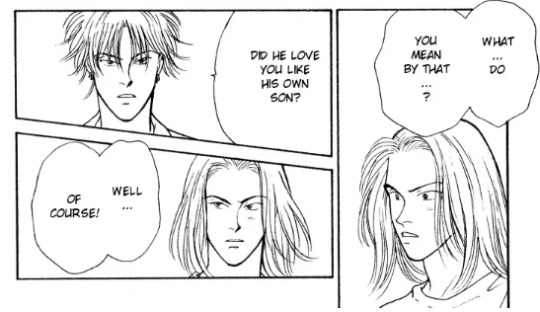
1.2 The artificial genius
The short story reveals some of Blanca’s past. He was chosen as a child prodigy when he was young. After 15 years, only 18 out of 300 children survived, Blanca being one of them. Thus he tells Dino: “To artificially create an elite – that’s a saying of utter nonsense in the first place. Mankind isn’t strong to such an extent.”
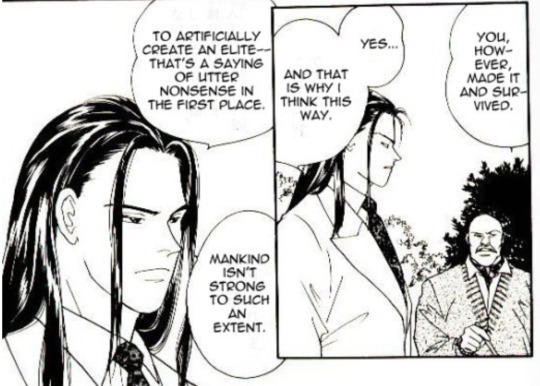
However, YASHA is precisely a story about the “artificial elites” and the problems they bring about. Sadly Blanca never appeared in the story, so we don’t get the chance to see his reactions about the matter…
2 The unqualified fathers
Although Yut-Lung and Rin are portrayed as opponents in the stories, they are not the real antagonists or villains. The “delinquent” fathers are the real villains in both stories.
Yoshida has a strong tendency to portray negative fatherhood. Even in her early work, “Kawa Yori mo Nagaku Yuruyaka ni (Longer and Softer Than River)” the absent father is the one who ruined the protagonist’s family and got him to where he is. In BF, we see at least 3 characters that claim to be the “father” of Ash: his biological father, Papa Dino and Max Lobo, and two of them are not doing a proper job. Eiji also comes from a family that the father is not functional (in "Fly Boy, in the Sky," his father has been sick for a long time so young Eiji was under a lot of stress, and Ibe was the one who helped him to get through.
In YASHA, things become even more apparent. We are presented with several unqualified fathers.
Amamiya Kyoichiro, the adoptive father of Rin, is basically a milder version of Dino. He is not a pervert, but a “control freak” who treated Rin as a good product. He isolated Rin from all others since childhood to prevent him from “wasting his talent” and uses him for his own goals. Once he found out that Sei was “better”, he would dump Rin without hesitation, which left Rin in utter desperation.
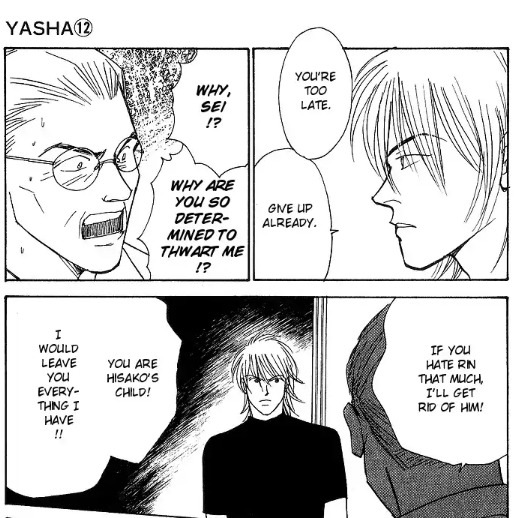
However, what makes the character even more interesting is his cowardice, not his power and wealth. Kyoichiro suffered from the violence of his own father - a tyrannical patriarch - for many years. The bravest thing he ever did was trying to get married with Hisako (Sei’s adoptive mother) without his father’s permission. For him, such “rebellion” or “sacrifice” gave him the right to control Hisako as if she owed him a debt, making the woman run away and steal baby Sei from the laboratory. Later, when Rin was abused by his father, Kyoichiro didn't dare to intervene. Because of his cowardice, Kyoichiro turned from a victim to a perpetrator, causing Hisako’s death and Rin’s twisted personality.
But, being the initiator of many tragedies, Kyoichiro kept doing what he believes to mean love. He tried to clone Hisako because she was “the perfect woman”. He was willing to offer Sei anything only if the kid went with his plan. And, like Dino, he finally gave his life to protect Sei (Rin), making him another complicated, mixed character. Love or possessiveness, who knows.
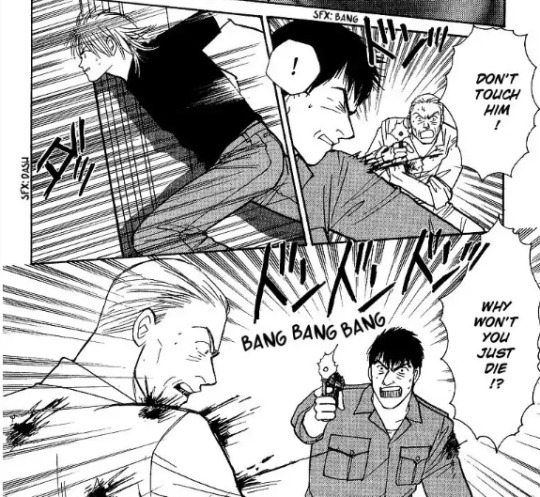
The fathers of the main supporting characters are no good either.
The father of Takeru (Rin’s partner) impregnated his mistress as his wife was infertile. Then he brought little Takeru back and let his wife raise him, causing the break-down of two women and the abused childhood of Takeru.
Ken’s stepfather was responsible for the suicide of his little sister.
The father of Raymond Goldberg was a violent pedophilia, and Raymond grew up to be exactly like him.
……
Among them, Takeru’s father was the only one who realized that they must stop passing on the tragedy to the next generation, which somehow helped Takeru escape from destruction.
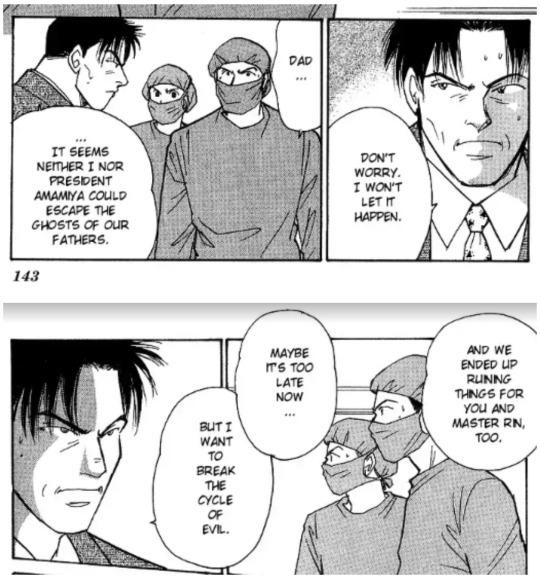
Personally, I feel that all these things make the ending of YASHA even harsher than BF. When Ash fell in the eternal dreams in the library, his soul was saved and filled with happiness. But Rin was staring at something that never belonged to him till the very last moment of his life, paying for somebody else’s mistake that had twisted his fate even before he was born.
3 The unconditional love
Love is another theme that Yoshida portrays in both BF and YASHA. What she keeps emphasizing is that the highest love is always “unconditional”. It’s something very close to “godly love”. It’s the way Eiji loves Ash, and the way Hisako loves Sei. Sei’s uncle Dr. Arisue, and his childhood friend Toshi also love him that way. “Love you whatever you do.” “Trust you under any circumstances.” – It’s a bit different from romantic love. In my personal opinion, that’s perhaps why Yoshida tends to deny the category of “BL” for BF, even stressed that Ash and Eiji’s relationship was “non-sexual” in “The Garden of Light”.
What would happen if people can’t love unconditionally? Perhaps the answer lies in Takeru’s question: “Why do people so easily become demons?”
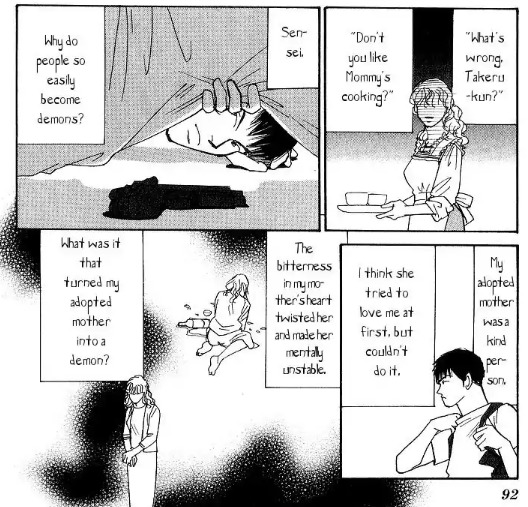
They just shouldn’t ask for anything in return.
===========================
Bonus 1:
It’s definitely not a good idea to be the protagonists in Yoshida’s works. Because they leave us, somehow, in some way, even in the next story.
As a main supporting character, Sing Soo-Ling is the luckiest guy. He lives through all three stories and even has a son (named Lie, with Ibe Akira).

Bonus 2:
According to the interview in the Official Guidebook of Banana Fish, Yoshida said that Blanca was initially designed to be a woman. She wanted to draw an affair between female Blanca and Ash, but the idea was stopped by the editor. (Thanks for the translation here.)
This is her illustration of female Blanca (photo by me):

In YASHA, she finally got things done. What a persistent author… And that scene between Sei and Ru-Mei leads to the story of another sequel, “Eve’s Slumber” .
Fin.
R 2019-2
37 notes
·
View notes
Text
Devilman Crybaby and the Occult: A Brief Examination
Akira as Lucifer
Akira in Japanese typically means “bright” or “clear,” primarily in the context of intellect. But if these concepts are applied to the matter of literal brightness, as in lightness, then Akira can be thought of as a representation of Lucifer. Specifically, in the sense that he is the “light bringer.” Lucifer typically is thought of as meaning “devil” but in actuality, the word translates in Latin Vulgate as “morning star,” or “the planet Venus” (the brightest planet) or of course, “light bringing.”
In many Gnostic, Luciferian and other esoteric schools of thought and occult ideology, Lucifer is not a figure of evil but instead he represents the principle of inner enlightenment, a guiding cosmic force of lightness. Another interesting fact is that phosphorus happens to mean “light bringer” in Greek,” and is a substance naturally occurring within all of our DNA – Luciferians argue that the power for spiritual growth and enlightenment comes not so much from external sources such as "God" in the orthodox way, but primarily from within us, recognizing our own abilities and powers.
This information does not come close to the rich history of Lucifer’s true identity but it offers us some fascinating insight into the realm of Devilman Crybaby. As mentioned, Akira can be thought of as “bright” (the connotation with the planet Venus implies he is found of things of beauty, peace, love) and as a light bringer in the sense that he is trying to bring forth change and illumination for a world in desperate need of a savior figure. Luciferianism emphasizes rebellion at cruelty and the intolerance of injustice as well, something which Akira understands and embodies perfectly.
His constant crying, his empathy, his emotionalism, this all grants him a sense of connectivity to humanity, even though once the truth of his identity is revealed the majority of the world still despises him. This is similar to the literal story of Lucifer, in that his identity has been proven to be based largely on fallacies and misconceptions, mistranslated scripture, and superstition, and yet nevertheless Lucifer seems doomed to forever bear humankind’s fear and loathing, much like Akira. There are a number of ways that Lucifer and Christ can be compared in these regards as well and by the time the series ends, Akira himself is forced into a state of what could be qualified as martyrdom.
Additionally, one of the most perplexing things to think about is that Ryo – who is truly Satan – finds Akira to be such a powerful and important figure in his life. In a sense, Akira is the light and brightness of his life: His role in Ryo’s life grants him purpose, it enlightens him into his true form, and so forth. Akira is Ryo’s Lucifer, essentially. This may sound confusing at first but bear in mind these points: 1). Lucifer and Satan are not necessarily the same person, 2). Much like many are familiar with the concepts of beings having the capacity for both good and evil or “God and Satan,” beings have the potential for Lucifer to enter their essence as well. And furthermore, another matter of interest is that some sources have speculated Lucifer and Satan to actually be two sides of the same being: Lucifer represents the spiritual, and Satan represents the earthly – this is similar to say, the holy trinity wherein multiple beings are actually one in the same. This would mean that Akira and Ryo are essentially the same entity.
To really make sense of these theories, one must dive deep into biblical lore, etymology, anthropological history, and occultism, and must be willing to keep an open mind. In actuality, the story of Lucifer is fundamentally simple but has been made incredibly convoluted over the years thanks to fear mongering, religious bigotry, and a myriad of other errors in human judgment. If you would like to know more on the nature of Lucifer, or further elaboration on the connection I perceive between Akira and Ryo, feel free to comment! In the meantime, I suggest “Lucifer: Princeps” by Peter Grey.
The Demons
The demons throughout the entire series are primarily based off of real spirits associated with demonology. Some date back all the way to the early ages of the clash between Abrahamic religions and ancient Paganism, some pertain to middle ages, etc. In particular, we have The Keys of Solomon to examine. The Key of Solomon itself is known as Clavicula Salomonis in Hebrew, and it is one of the most important examples of Renaissance era magick – from here, the more infamous Lesser Key of Solomon, or the Clavicula Salomonis Regis, was believed to have been written in the 17th century.
Both books deal with magical operations influenced from Jewish Kabbalah, pertaining to workings with various different spirits, but The Lesser Key in particular is known for one of its five different segments: The Ars Goetia. The Goetia bases itself on pre-existing sources of information on demons such as the PseudodomonarchaDaemonum (1577) and it offers rankings, information, and general descriptions of the 72 major demons. Each demon has their own ability, and they are divided into categories such as King, Duke, Prince, Marquis, President, Count, etc.
Demons are not limited to these sources, and many demons or demon-like spirits exist separate from the Goetia (e.g. the Djinns of Arabic spirituality). Further, the issue of whether or not demons are inherently evil is widely debated and much of it goes back to the matter of linguistics. In another article I wrote about demonology (linked below) you’ll see what I mean more clearly, but the key thing to remember is that a “daemon” simply means a wise, intelligent spirit. The evil spirits we are familiar with as demons were either developed as early Christianity’s opposition to “Pagan” idols (e.g. Baal became an honorific title of Lord into one of the most well known demons, Beelzebub became “lord of all that flies” into “lord of the flies”).
In Devilman Crybaby, there are a whole lot of demons. I will not be addressing all of them, but chief among them is Amon, the demon which merges with Akira. Amon is considered in magical lore to be a Marquis of Hell, governing 40 legions of spirits and as described in the Pseudomonarchia Daemonum:" [He] is a great and mighty marques, and commeth abroad in the likeness of a Wolf, having a serpents tail, [vomiting] flames of fire; when he putteth on the shape of a man, he sheweth out dogs teeth, and a great head like to a mighty [nighthawk]; he is the strongest prince of all other, and understandeth of all things past and to come, he procureth favor, and reconcileth both friends and foes, and ruleth forthy legions of devil.”
And by S.L. MacGregor Mathers in the his translation of the Goetia: "The Seventh Spirit is Amon He is a Marquis great in power, and most stern. He appeareth like a Wolf with a Serpent's tail, vomiting out of his mouth flames of fire; but at the command of the Magician he putteth on the shape of a Man with Dog's teeth beset in a head like a Raven; or else like a Man with a Raven's head (simply). He telleth all things Past and to Come. He procureth feuds and reconcileth controversies between friends. He governeth 40 Legions of Spirits.” Amon also shares a connection with the Egyptian god, Amun.
Less obvious references are made, sometimes in the form changed spellings. For instance, Kaim instantly reminded me of the demon Caim, a blackbird said to have knowledge of rhetoric, wisdom, and the ability to understand certain animals. Some other demonic figures that appear throughout the series – not so much the new adaptation – include Pazuzu, Lilith and Beelzebub, which shows that the series is not limiting its demonic lore to merely one source (i.e. Pazuzu pertains to Mesopotamian religion whereas Lilith for instance pertains to Hebrew sources of wisdom).
Where is God? And What About the Cycle of Life/Samsara?
This is a tricky one to pinpoint, because the more you attempt to wrap your head around all the different theories, the more you will be left wondering how certain things could have happened, what the nature of God truly is, and so forth. There is a lot of biblical inaccuracy to the show, but in comparison to Gnosticism and other ancient ideologies, God’s role actually makes more sense from these perspectives. For example, some Gnostic sects believe it was the Demiurge who created this world as a sort of “prison,” rather than God representing an all loving and benevolent force. But in the context of Devilman Crybaby, I would say the best explanation we have regarding his absence is the concept of Deus Absconditus which means “[A] god who in his remoteness seems to ignore human suffering,” or similarly, Deus Otiosus which means that God is idle and no longer involved in humanity’s concerns. Theories like these have broad implications with esoteric Christianity and other religions, and so it is hard to gauge how true they may be for Devilman Crybaby. One thing is for sure, the classical concept of Deus Ex Machina never occurs in the show, which does give more credibility to the idea that God may simply not care, be idle, or at the least, His plan is one that we the audience are not made aware of.
Another possible theory is that Satan himself is God. Utilizing a solipsistic framework, similar to what we see Shinji Ikari go through at the End of Evangelion, we see Satan completely and utterly alone in the world. He seems to have complete control over just about everything except for Akira’s death and his feelings. But if he himself were in fact God, could he not choose to end things right then and there. Evidence for this comes in the fact that, ironically, the creators held very true to biblical descriptions of Satan as being the most beautiful, initial, favorite, and most beloved being of God. The fact that he was so much immense power. And the fact that Ryo essentially must awaken to his higher self as Satan is symbolic of the one becoming a God and/or one realizing they are living in a solipsistic world. Solipsism is essentially the idea that you cannot prove anything or anyone outside of you truly exists, that you yourself may be represent the universe and all else is merely an illusion, speculation, or incapable of ever being seen as absolutely certain. If Satan were to have all of these traits, in some aspect, could this not make him a God of sorts? Upon realizing it, he chooses to kill himself and the world and begin the cycle all over again – notice the wheels within wheels that constantly appear during the explosions, these are in my opinion, references to the angelic visions of God’s chariot that the prophet Ezekiel saw.
So basically, Satan is willing himself into another incarnation (I believe that reincarnation applies more to this show due to the fact that Ryo awoke to a past life, as opposed to the idea that by destroying the cycle of life, death, rebirth – samsara – then everything would simply end for all eternity). It seems as though Ryo/Satan enjoys mind games, puzzles, challenges, etc. and so what better challenge than to repeat the process of rediscovering one’s true existence? Or, perhaps Akira represents God and in his final moments on screen, we are witnessing Satan’s ultimate punishment. The idea of Hell is an incredibly complex one, but the main point in Christian scripture is that it is a place in which there is only the absence of God – if Akira represented God and now is lost forever, this serves as Satan’s eternal suffering; God has abandoned him.
Miki the Witch/Color Theory
Miki is frequently referred to as a witch on numerous occasions, and at first we take it primarily as a bad joke based out of ignorance and fear. She certainly possesses some interesting traits such as her speed and agility, but is she really a witch? The answer to that, in my opinion, depends on how you look at things. During the witch trials that took place throughout Europe and of course Salem, women were accused of witchcraft for the slightest of “misbehavior.” Women who were particularly good at something on their own were very much victims of this curse; it was believed often times, a woman simply could not perform abilities of any kind to such excellence without the aid of magic, devils and demons, and so forth.
But in Miki’s case, I think one of the more subtle elements of this matter has to do with her clothing choices. In many scenes, she is wearing green. Green is actually quite an important color in witchcraft, Paganism, alchemy, you name it. It is the color of the heart chakra – Miki representing much of Akira’s love and devotion, his heart. It is associated with the zodiac sign of The Mother Goddess, a figure of Wicca and other Neo-Pagan beliefs who brings forth peace, fertility, prosperity, abundance, luck and deals with matters pertaining to envy, changing attitudes, the environment, and so forth. More “ominously” if such is to be believed, green does carry a more “Satanic” principle of to itself – as explained even in classic anime such as Belladonna of Sadness, it is a symbol for power (green = the color of nature, nature being Satan’s forest in some mythological/religious lore). Other theories – whether as overt as Satanism and witchcraft or more benign such as Hindu, Buddhist, and Taoist conceptions of colors can be applied to Miki
Color theory is important to bear in mind when examining all of the characters and scenes as well. For instance, the variety of colors that appears during the Sabbath could perhaps be reflective of a third eye awakening/demonic transformation/etc. As each color represents the seven chakras. The white and black dichotomy between Akira and Ryo is also one that clearly conjures forth images of duality such as the famous yin and yang symbol.
Conclusion
This is merely a short list meant to open the discussion on the new adaptations of Devilman Crybaby and how different realms of spirituality, the occult, the supernatural, religion, faith, and so much more play a larger role in shaping the development of things than you may realize. There are other examples to work with: Akira attempting to pass Ryo the torch and him neglecting it could be a sign of rejecting Lucifer/Christ/some sort of savior figure, it could even be thought of as something more symbolic of phallic imagery with regards to a sort of “creation” origin or the relationship between Ryo and Akira themselves. Everyone seems to be running, runners usually go at the start of gun’s loud bang; the big bang perhaps? Some things may seem like reaching, but just keep calm and think, do research, and come up with your own conclusions, there is more than meets the eye to Devilman Crybaby. Occultism pertains to that which is hidden, so it is up to the viewer to figure these sorts of things out. Also worth mentioning, the subject of will Aleister Crowley is known for the development of Thelema, which states that the purpose of life essentially to discover and fulfill one’s true will. How might this relate to the characters for instance? Again, there are a lot of starting points to go off of here, these are just springboards and suggestions.
Post this however you would like, if you’d like to make any YouTube videos inspired by these subjects just please credit me, Kvlt ov Romance in the description.
My post on demonology.
#devilman crybaby#ryo#akira#light#bright#venus#celestial#anime#manga#miki#rap#hip hop#music#art#japan#netflix#satan#lucifer#god#demon#angel#spirit#theory#fan theory#writing#crowley#thelema#witch#wicca#kvlt ov romance
157 notes
·
View notes
Note
Holy shit. Need your post about roma's revelation
Who saw that coming? Here I was thinking she’d get one-shotted! The thing about the Clowns is they all love playing with other people like puppets too much to really function as a cohesive organisation, and the wiser the prey the more enjoyable the hunt. We’d already seen some of this with Furuta, who tries to play the Clowns like everyone else, but I doubt even he has any idea that he, too, is being played by Roma. I thought for sure Donato was the true brains behind the Clowns, but from a group as chaotic as they, we can expect one twist after another.
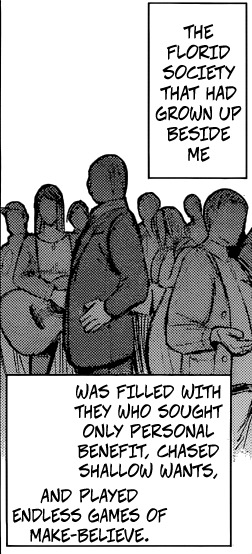
Potentially a meta-jab from Roma/Ishida. Yes, I’m spending my day reading manga and yes, I did spend way too much on TG merch. You can’t peddle the poison then blame me for getting sick, sensei ;-;

Loved the quote from Juvenal - goes to show Roma’s literary interest, the mark of a meta-character, as well as explaining the Circus imagery behind her organisation. For some context, the satirical poet Juvenal mocks how the Roman people no longer care about politics and only for food (bread) and entertainment (circuses). The Clowns are all about Satire, so the quote is fitting, especially as how the rest of Ghoul-kind view people solely as their bread. It’s the latter part that the Clowns focus on. The Ghouls provide the food, while the Clowns provide the entertainment.

Roma’s alias speaks to the heart of her character - a homeless wanderer. Roma has no place in the world, so she created an organisation that stands apart from it.
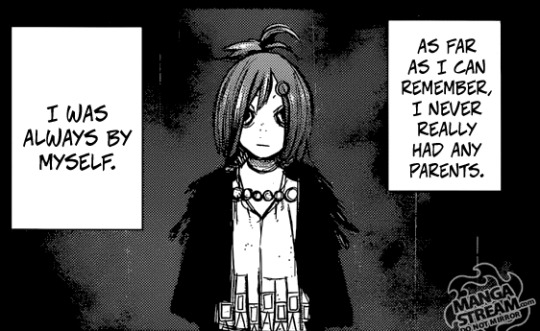
The first panel reminds me very much of Uta’s comment back in 116:


All the Clowns seems to have led horribly lonely lives that led them to become who they were. We know Furuta experienced this as well. That kind of experience lends itself well to the individualist and isolationist philosophy of the Clowns. Without any connections, they can treat the world as a story separate from themselves. Their existence is also a metafictional comment on our own; fandom, and our consuming fascination with stories, more often than not arises from our own prior loneliness. The Clowns are fans and writers just like we are - only, they do so for their own world, not someone else’s.

Because the world has given them such great tragedy, and because they have no Hide or Anteiku of their own to ground them, they cannot cope with it; so they convert it into comedy - something they can take pleasure in rather than pain.

And so they contribute to the greater tragedy and willingly become its thralls.

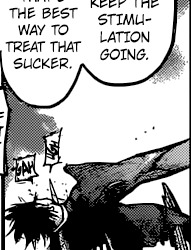
And here Roma makes the link between her depression and her depravity very clear. Her grand games serve simply as a distraction from her existential torment - and Roma’s view is that the grand games of everyone else serve much the same purpose, too. The hunt of the Doves and the rebellion of the Ghouls are, to her, unified battles against ‘boredom’, or, more accurately, ennui from living in a tragic world - and given what she knows about both Kaneki and Furuta, she may have a point. Very Toads Revisited.
So, when Furuta talks about ‘Super Peace’, he’s really talking about constant violence - the only kind of peace there is in the war against ‘boredom’. So following that train of logic, in the panel below, there’s no contradiction at all between what he’s thinking and what he’s saying.
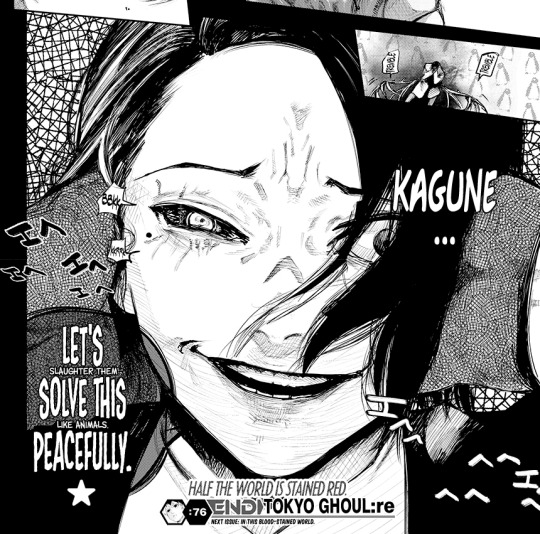
This is how the Clowns have been able to work with V thus far. V also encourages ‘Peace’ through a state of constant war. Very 1984 - and fascist in general, for that matter; Hitler’s ideal world outlined in Mein Kampf was a state of constant war to keep the ‘master race’ in their fighting prime.

Of course, the difference is that V uses this war to foster order, while the Clowns use it to foster chaos - and they aren’t afraid to collude with the enemy to achieve that. Something which will surely be a thorn in their relationship in the chapters to come…

Roma speaks to both Furuta and Kaneki here. She doesn’t give a fig who wins, so long as the parade continues. Thus why Nico helped Goat find a cure for Akira; just to keep the ride running.

And finally we reach the “Oh shit boi” panel of the chapter - Roma’s suitably hideous Pierrot-Meets-Mothra-Meets-Victreebel kakuja. Her alias here refers to her status as Mother of the Clowns, and ‘dodgy’ - well, Roma’s not exactly a reliable and trustworthy person. But what’s most interesting here is Roma’s throwaway comment - and what it might have to do with her thoughts before her transformation.
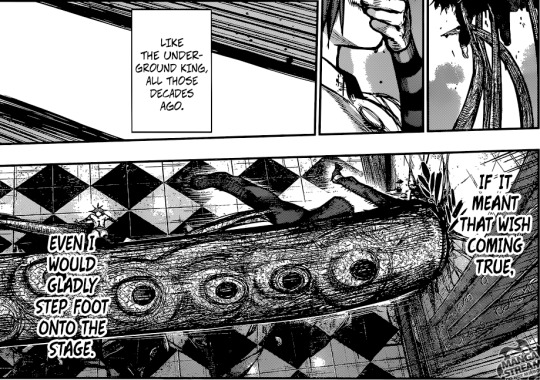
The former One-Eyed King was active, in Nishiki’s words, when your “gramps and grammies were kids like you”, and he stated that humanity was vulnerable to the King because “they were still exhausted from the war”. A seven-year old today would be born in 2010 (assuming the series is roughly parallel to our timeline), have a parent born around 1985, and a grandparent around 1965, so we can assume the insurgence happened in the 70s. The war comment might warrant it being placed earlier, but the effects of WW2 were still felt that late on. Roma is 51 years old, and so would be born in 1966 - the right age to wreak havoc as a child during the insurgency period just like Eto did.
So my question is: Did Roma rebel with the original OEK, for the biggest circus in town? Is he the ‘Demon Tsune’ she refers to? It sounds like a nickname for ‘Demon Kitsune’, a kind of Japanese fox spirit with nine tails. We’ve already seen the naagas, which I believe to be his kagune; perhaps nine of these once sprouted from his back? [Edit: Been informed that ‘Demon Tsune’ was the nickname for Tsuneyoshi Washuu, who Roma presumably lost to, so ignore most of that] As we all know, the OEK lost, which explains why Roma says it won’t go like it did back then as well as how she became interned in Cochlea in the first place. Some food for thought.
I’ll be following Roma’s movements much more carefully from now on. She is the literary Jack-In-The-Box; you know a Clown’s going to pop out, but it’s a lot scarier than you anticipated.
154 notes
·
View notes